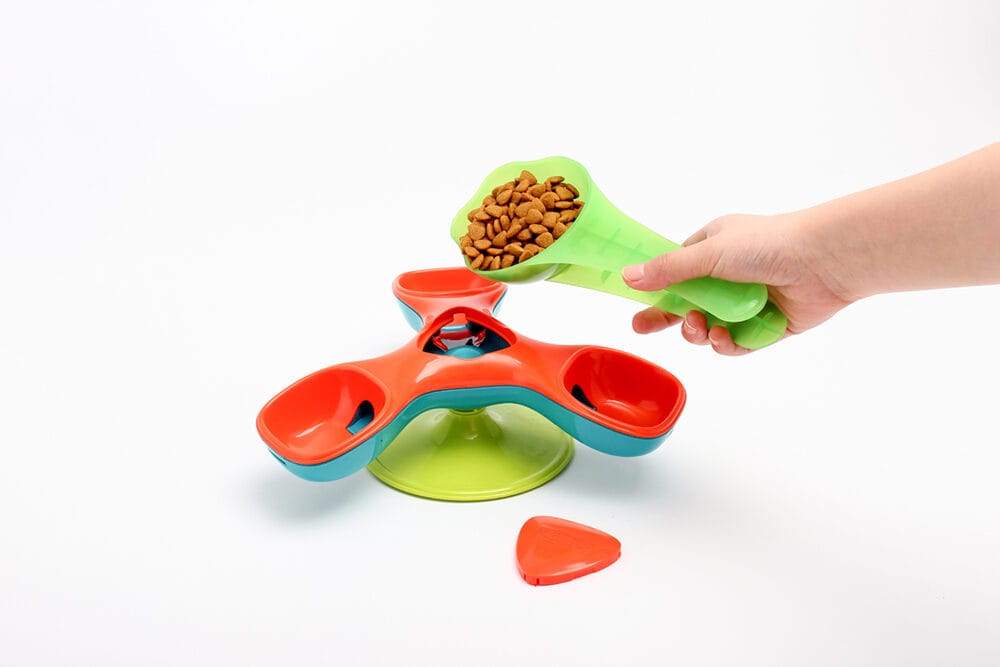In recent years, slow feeders have moved from niche pet shop shelves to a common recommendation from veterinarians and behaviourists. These specially designed bowls and mats, often featuring ridges, mazes, or raised sections, encourage dogs to eat more slowly, and the benefits go far beyond just tidier mealtimes.
The benefits of slow feeders
1. Reducing the risk of bloat
One of the most serious health concerns linked to rapid eating is gastric dilatation-volvulus (GDV), or bloat. This is a life-threatening condition in dogs where the stomach fills with gas and can twist. Large and deep-chested breeds, such as Great Danes, Weimaraners, and Setters, are particularly at risk.
While bloat can occur for multiple reasons, eating too quickly is considered a contributing factor. By slowing a dog’s eating pace, slow feeders may help reduce the likelihood of excessive air swallowing (aerophagia) and the subsequent risk of GDV.
2. Supporting healthy digestion
Fast eaters often gulp down food without adequate chewing. This can lead to choking, gagging, or regurgitation shortly after meals. It also puts strain on the digestive system, as larger food particles require more work in the stomach and intestines.
A slower eating pace gives the stomach more time to signal satiety to the brain, potentially reducing the risk of overeating and associated gastrointestinal discomfort.
3. Weight management and satiety
Obesity is one of the most common health issues in domestic dogs. Slow feeders can play a role in weight control by prolonging mealtimes, which may help dogs feel full on less food. Research in both humans and animals shows that eating slowly can improve satiety signals, reducing the urge to overeat.

4. Mental stimulation and enrichment
For dogs, eating is more than a physical necessity; it’s an opportunity for mental engagement. Slow feeders turn mealtime into a problem-solving exercise, engaging natural foraging instincts.
For high-energy or easily bored dogs, this extra mental stimulation can help reduce undesirable behaviours such as destructive chewing or excessive barking that result from under-stimulation.
Did you know?
From exuberant puppies who inhale every meal to senior dogs who benefit from more deliberate chewing, slow feeders are suitable for dogs at every life stage. They come in a variety of designs and difficulty levels, meaning they can be adapted to your dog’s size, breed, and ability.
5. Improved nutrient absorption
Slower eating can aid in better digestion and nutrient uptake.
6. Reduced risk of choking
The physical barriers in slow feeders help prevent large mouthfuls and reduce the risk of choking or regurgitation after eating.
7. Positive routine addition
Slow feeders can help dogs learn to approach food more calmly, which can reduce food-related aggression in multi-dog households.
Six signs your dog eats too fast:
- Gulping food without chewing
Your dog swallows large mouthfuls with little or no crunching. - Finishing meals in under a minute
A bowlful disappears almost instantly after it’s put down. - Coughing, gagging, or choking at mealtimes
Rapid eating increases the risk of airway blockage. - Vomiting or regurgitating soon after eating
Large, unchewed pieces are harder to digest. - Excessive burping or flatulence
Fast eating can cause your dog to swallow excess air. - Guarding the food bowl
Eating quickly may be a sign of resource guarding or anxiety around food.
If you notice one or more of these signs, a slow feeder could make mealtimes safer, calmer, and more enriching for your dog.

Choosing the right slow feeder
When selecting a slow feeder, consider:
- Material: BPA-free plastic, stainless steel, or silicone.
- Ease of cleaning: Dishwasher-safe designs reduce bacterial build-up.
- Size and shape: Match the bowl to your dog’s muzzle size and feeding style.
- Difficulty level: Some dogs benefit from simple ridges, while others need more intricate mazes for an effective slowdown.
Bottom line
Slow feeders are a simple, relatively inexpensive tool that can improve digestion, reduce health risks, and enrich your dog’s daily life. For most dogs, the change in mealtime pace is worth the small investment, and the peace of mind it brings to us!
As always, if your dog has a history of digestive problems, choking, or weight fluctuations, consult your vet before making significant changes to their feeding routine.


